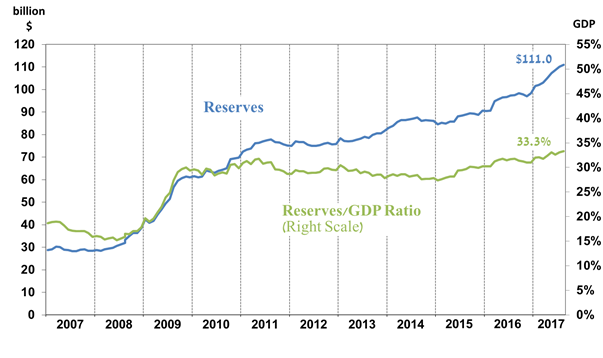The increase was the result of:
a. Government transfers from abroad totaling about $423 million.
b. A revaluation[1] that increased the reserves by about $540 million.
The increase was offset by private sector transfers of about $53 million.
Israel's Foreign Exchange Reserves
$ million
|
Date |
Reserves bought under the natural gas purchase program |
Reserves excluding IMF (including reserves bought under the natural gas purchase program) |
Reserves at the IMF[2] |
Total Foreign Exchange Reserves |
|
August 2016 |
9,900 |
96,588 |
1,038 |
97,626 |
|
September 2016 |
9,900 |
97,380c |
1,049 |
98,429c |
|
October 2016 |
10,200 |
96,931 |
1,032 |
97,963 |
|
November 2016 |
10,200 |
95,948 |
1,179 |
97,127 |
|
December 2016 |
10,500 |
97,275c |
1,172c |
98,447c |
|
January 2017 |
10,500 |
100,430c |
1,183 |
101,613c |
|
February 2017 |
10,750 |
100,843 c |
1,179 |
102,022c |
|
March 2017 |
10,750 |
101,992c |
1,182 |
103,174c |
|
April 2017 |
11,000 |
103,949c |
1,193 |
105,142c |
|
May 2017 |
11,250 |
106,163 |
1,204 |
107,367 |
|
June 2017 |
11,390 |
107,499 |
1,207 |
108,706 |
|
July 2017 |
11,540 |
108,733c |
1,377 |
110,110c |
|
August 2017 |
11,540 |
109,642 |
1,378 |
111,020 |
Figure 1
Level of foreign exchange reserves, and their ratio to GDP, 2007–17

[1] This includes Bank of Israel payments and receipts in foreign currency.
[2] This column includes Special Drawing Rights (SDRs), the balance of NAB loans, and the balance of Israel's reserve tranche in the IMF.
c Updated after the original date of publication.
 Graphs and Data
Graphs and Data